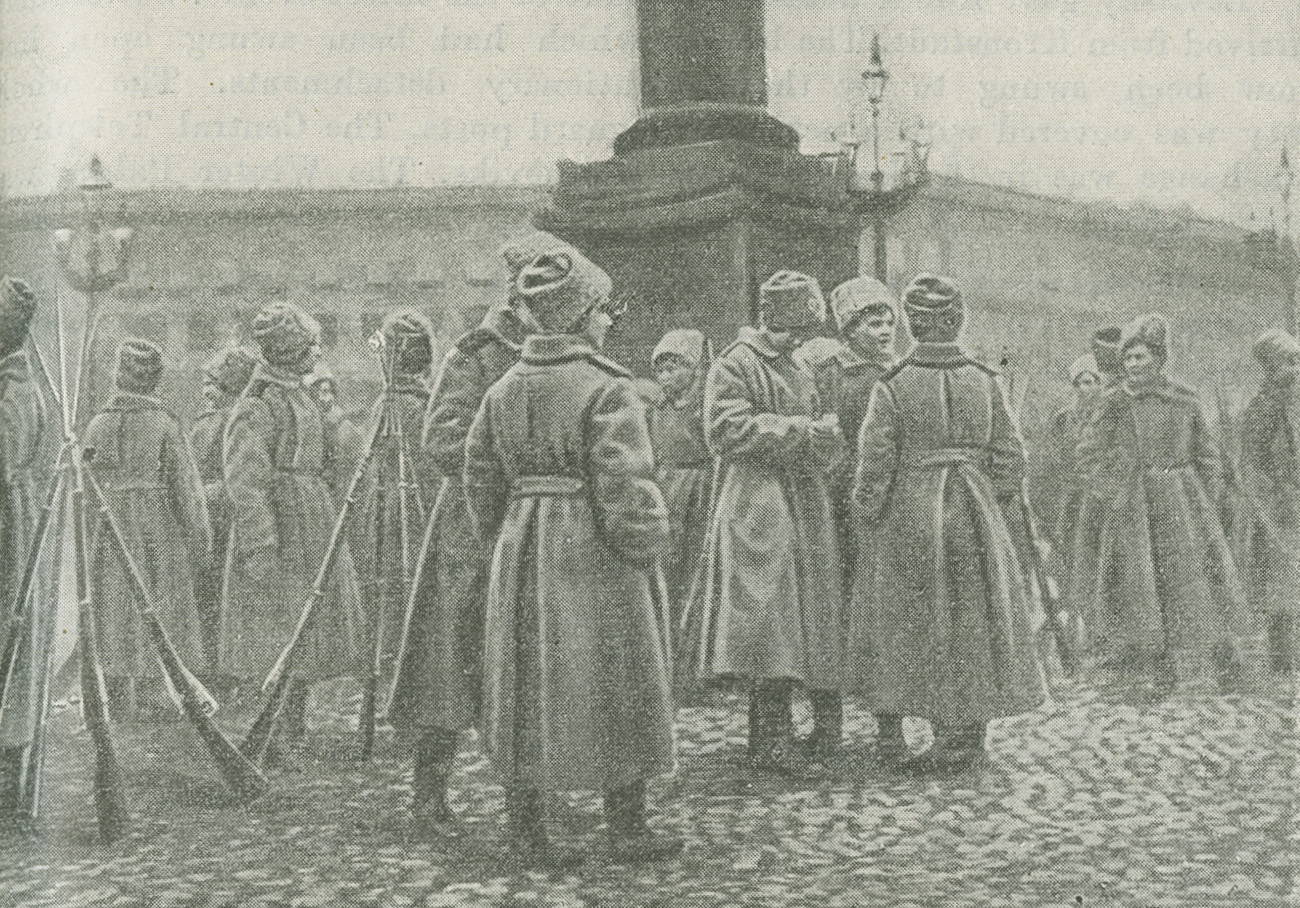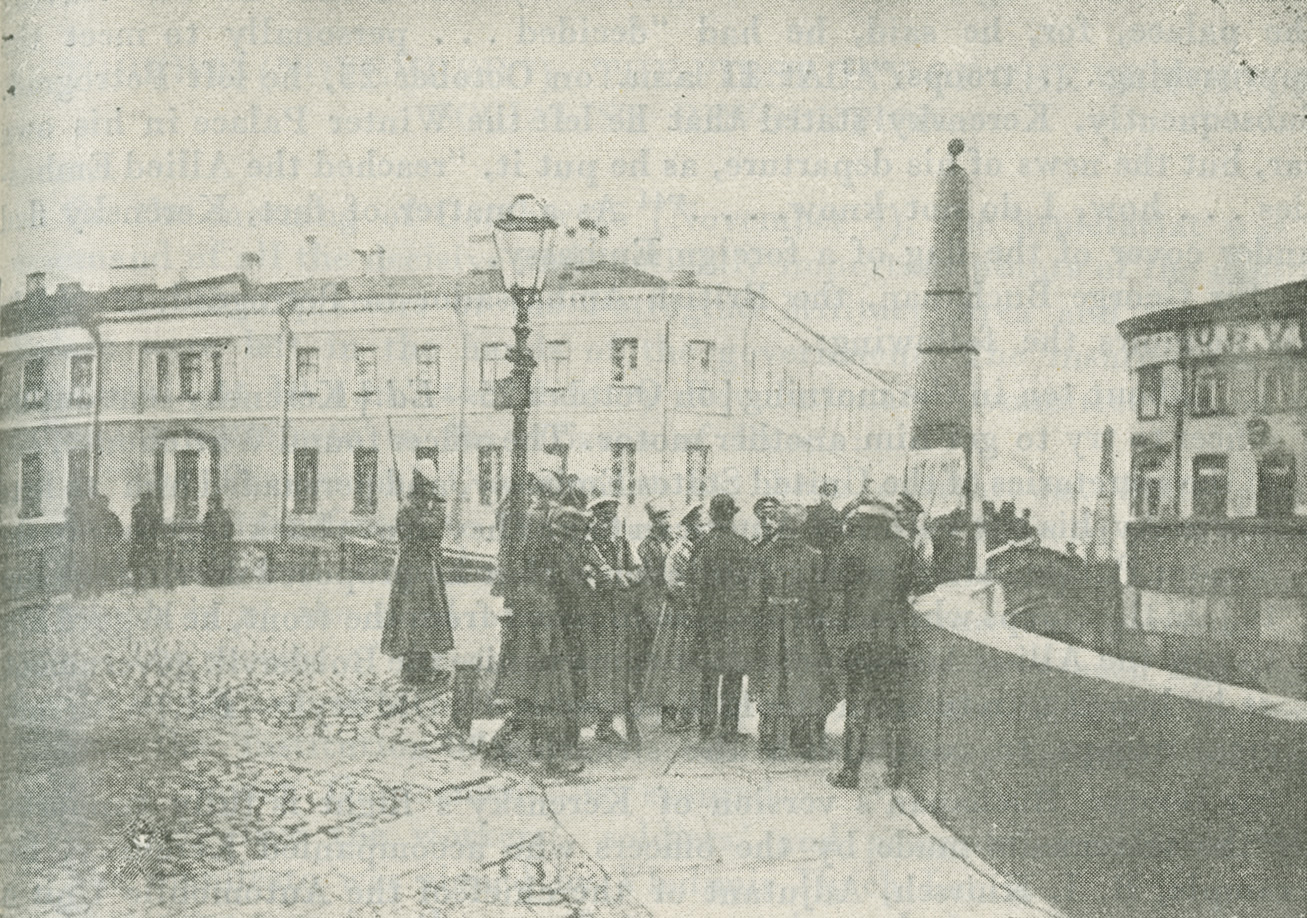
The Provisional Government exerted its last efforts to muster a force for its defence.
At 2:20 a.m. on October 24 (November 6), General Levitsky, Kerensky’s Adjutant, telephoned General Headquarters and conveyed two urgent telegrams from Kerensky as Supreme Commander-in-Chief, to General Dukhonin, Commander-in-Chief of the Northern Front, categorically demanding that the orders they contained he obeyed forthwith. The first telegram read as follows:
“I order you, on the receipt of this, to dispatch by rail to Petrograd, Nikolayevsky Station, all the regiments of the 5th Caucasian Cossack Division with all their artillery, the 23rd Don Cossack Regiment, and all the other Cossack units in Finland under the general command of the chief of the 5th Caucasian Cossack Division, where they are to place themselves at the disposal of Colonel Polkovnikov, the chief of the Petrograd Military Area. Inform me by coded telegram of units’ departure. In the event of it being impossible to dispatch by rail, send units in echelons in marching order.”[1]
In the second telegram, Kerensky ordered the regiments of the 1st Don Cossack Division, which were distributed along the Northern Front, to be collected and dispatched to Petrograd. He took the precaution to add that the regiments be dispatched by road if the railwaymen prevented them from obtaining transport. It was mainly the Cossacks that Kerensky relied upon to defend the Winter Palace.
On receiving Kerensky’s telegram, Dukhonin immediately called up General S. G. Lukirsky, Chief of Staff of the Northern Front.
The General reported that two regiments of the 1st Don Cossack Division had just reached Reval, and that two others had in the morning of October 24 left for the First Army to disarm an infantry division which had refused to obey orders.
Dukhonin ordered the General to dispatch any Cossack unit that was available, as the situation brooked no delay. To confirm this he added that he had just received the following telegram from Kerensky’s Adjutant-General:
“Actually, at the present moment, the Petrograd garrison, with the exception of a few units, is on the side of the Bolsheviks, or else neutral. Evidently, the Winter Palace is surrounded, and events are taking a grave turn. Inform Cheremisov of this. Probably, it will soon be impossible for me to communicate with you, Levitsky.”[2]
Northern Front Headquarters answered that all the necessary orders had been issued. The first to arrive in Petrograd would be companies of the Cycle Battalion, which were already at Batetskaya Station, waiting to entrain.

Towards morning Dukhonin called up Levitsky at the Winter Palace. “I am very glad to be able to talk to you,” he said,[3] and then reported all the measures General Headquarters and the Staff of the Northern Front had taken. The 44th Infantry Division with two batteries, the 5th Caucasian Cossack Division with its artillery, and the 43rd Don Cossack Regiment were being sent to Petrograd. Furthermore, the 13th and 15th Don Regiments with their artillery were being dispatched from the Northern Front, and the regiments of the 1st Don Cossack Division, which had been sent to the First Army, had been ordered to change their route and go to Petrograd. The 3rd and 6th Cycle Battalions were already proceeding along the railway, and Dukhonin suggested that “trustworthy persons” should be sent out to meet them. He also suggested to the Staff of the Northern Front that the units they sent should be accompanied by elected representatives of the Army Committees. It was the mission of the Socialist-Revolutionaries and the Mensheviks to incite the troops against the revolution.
In conclusion, Dukhonin requested Levitsky to give a brief description of the situation which could be communicated to all the fronts.
Levitsky gave him a detailed account of the latest events. Sailors had arrived from Kronstadt. The bridges which had been swung open had now been swung to by the revolutionary detachments. The whole city was covered with a network of guard posts. The Central Telephone Exchange was in the hands of the Bolsheviks. The Winter Palace was surrounded.
“On the whole,” said General Levitsky in conclusion, urgently requesting that troops be dispatched from the front, “the impression one gets is that the Provisional Government is, as it were, in the capital of a hostile state, which has completed the mobilisation of its forces, but has not yet commenced active operations.”[4]
At about 4 a.m. on October 25, Kerensky arrived at Headquarters of the Petrograd Military Area, but the news he heard there was anything but consoling. The key positions were in the hands of the enemy; reinforcements could not be obtained anywhere; the units which had promised to assist had gone over to the side of the revolutionaries.
He called a conference at Military Area Headquarters, at which it was decided to call out the 1st, 4th and 14th Don Cossack Regiments which were stationed in Petrograd. The following telephone message was sent out to these regiments.
“In the name of the freedom, honour and glory of our country, and the salvation of dying Russia, the Supreme Commander-in-Chief orders the 1st, 4th and 14th Cossack Regiments to come to the assistance of the Central Executive Committee of Soviets of revolutionary democracy and of the Provisional Government.”[5]
This message was signed by Major-General Bagratuni and countersigned by Malevsky, the Commissar of the Central Executive Committee.
The Cossacks were aware that their barracks were completely surrounded by Red Guard patrols and that thousands of workers from the Moscow, Narva and Peterhof Districts would come pouring into the streets at any moment in order to prevent them from taking action. They enquired of Headquarters whether the infantry would act with them. If not, they would not move, they said.
Early in the morning, Kerensky left the Petrograd Military Area Headquarters and returned to the Winter Palace.
Here there was a shortage of provisions. In concentrating in the palace a large force numbering about 1,600, the government had not dreamed that it would be cut off from the outside world in the course of a single day and had made no arrangements to take in a sufficient stock of provisions. On the night of the 24th, the food crisis in the palace was already so acute that cadets had to be sent out on a foraging expedition. A motor truck containing cadets in quest of provisions was held up by Red Guards at the Nikolayevsky Railway Station and taken to the Smolny.

Meanwhile, the forces on which the Provisional Government depended continued to dwindle. Subsequently, Kerensky wrote:
“The cadets, who were in excellent spirits at first, began to lose heart. Later, unrest broke out among the Armoured Car Detachment. Every minute of fruitless waiting for reinforcements caused the ‘fighting efficiency’ of both units to deteriorate.”[6]
After a meeting held in the Mikhailovsky Riding School, the majority of the men of the Armoured Car Detachment went over to the side of the Military Revolutionary Committee. Later, at 11 a.m. on October 25, the entire detachment appeared at the Smolny and placed itself at the disposal of the Military Revolutionary Committee.
The Winter Palace had only one armoured car left, the Akhtyrets, the crew of which stated that it intended to defend the palace as “a monument of artistic value.”[7]
Another meeting of the government was called. Cabinet Ministers, army officers and couriers hurried to and fro between the Winter Palace and the Military Area Headquarters. From all sides rumours came pouring in, each more alarming than the other. The situation became extremely tense.
At the meeting of the Cabinet Kerensky stated that he was leaving the palace, for, he said, he had “decided . . . personally to meet the approaching . . . troops.”[8] At 11 a.m. on October 25, he left Petrograd. Subsequently, Kerensky stated that he left the Winter Palace in his own car, but the news of his departure, as he put it, “reached the Allied Embassies . . . how, I do not know. . . .”[9] As a matter of fact, Kerensky fled under cover of the flag of a foreign Embassy.
Sir George Buchanan, the British Ambassador in Petrograd, stated in his memoirs the following:
“About ten in the morning [on October 25—Ed.] Kerensky sent out an officer to try to get him another motor. The officer found Whitehouse, one of the secretaries of the United States Embassy, and persuaded him to lend Kerensky his car with the American flag. They drove back together to the Winter Palace. After telling Whitehouse that he proposed driving to Luga to join the troops which had been summoned from the front, he begged him to ask the Allied Ambassadors not to recognise the Bolshevik government, as he hoped to return on the 12th [October 30, Old Style—Ed.] with sufficient troops to re-establish the situation.”[10]
Sir George Buchanan’s version of Kerensky’s flight is fully supported by the statements made by the officers who accompanied Kerensky. For example, B. I. Knirsch, Adjutant of the chief of the Automobile Unit of the Petrograd Military Area, related that at 10 a.m. he was called to Staff Headquarters where Colonel Polkovnikov instructed him to procure two cars for Kerensky, who intended to go out to meet the approaching troops. He advised him to apply to one of the Embassies. Knirsch obtained a car from an American and together with the Military Attaché of the United States Embassy he returned to Staff Headquarters. When the car flying a foreign flag came out on the square the Red Guards allowed it to pass.
It was not by “accident” that Kerensky found a foreign car; and the car did not keep “at a respectable distance.” The foreign flag enabled the head of the Provisional Government of Russia to flee from revolutionary Petrograd.
The revolution swept on with irresistible force. Every attempt on the part of the Provisional Government to resist the triumphant progress of the insurrection was immediately thwarted. The Cabinet Ministers could do nothing else but lock themselves in the Winter Palace and wait fruitlessly for the arrival of troops from the front.
[1] “Documents,” Arkhiv Russkoi Revolutsii, Vol. VII, Berlin, 1922, p. 286.
[2] Ibid., p. 287.
[3] Ibid., p. 288.
[4] Ibid., p. 290.
[5] “The Course of Events,” Novaya Zhizn, No. 163, October 26, 1917.
[6] A. F. Kerensky, From Afar, Compendium of Articles 1920-1921, Paris, 1922, p. 202.
[7] “The Narrative of a Defender of the Winter Palace,” Rabochaya Gazeta, No. 197, October 27, 1917.
[8] A. F. Kerensky, From Afar, Compendium of Articles 1920-1921, Paris, 1922, p. 203.
[9] Ibid., p. 204.
[10] Sir George Buchanan, My Mission to Russia and Other Diplomatic Memories, Boston, Little, Brown & Company, 1923, Vol. II, p. 205-06.
Previous: At the Staff Headquarters of the Revolution
Next: October 25 (November 7)—The First Day of the Victorious Socialist Revolution